Page 71 of 394
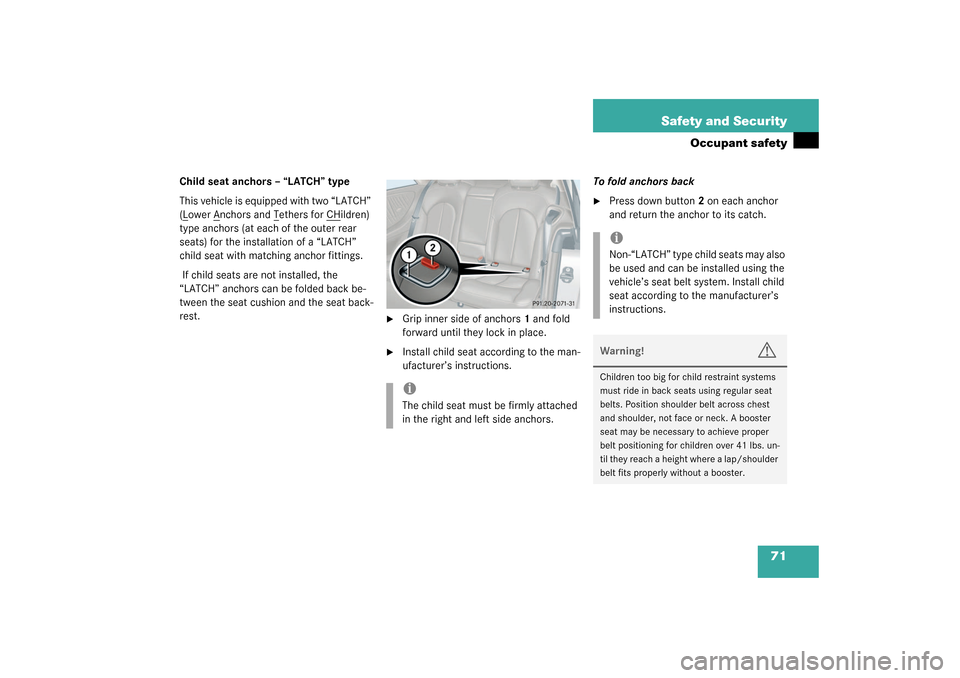
71 Safety and Security
Occupant safety
Child seat anchors – “LATCH” type
This vehicle is equipped with two “LATCH”
(Lower A
nchors and T
ethers for CH
ildren)
type anchors (at each of the outer rear
seats) for the installation of a “LATCH”
child seat with matching anchor fittings.
If child seats are not installed, the
“LATCH” anchors can be folded back be-
tween the seat cushion and the seat back-
rest.
�
Grip inner side of anchors1 and fold
forward until they lock in place.
�
Install child seat according to the man-
ufacturer’s instructions.To fold anchors back
�
Press down button2 on each anchor
and return the anchor to its catch.
iThe child seat must be firmly attached
in the right and left side anchors.
iNon-“LATCH” type child seats may also
be used and can be installed using the
vehicle’s seat belt system. Install child
seat according to the manufacturer’s
instructions.Warning!
G
Children too big for child restraint systems
must ride in back seats using regular seat
belts. Position shoulder belt across chest
and shoulder, not face or neck. A booster
seat may be necessary to achieve proper
belt positioning for children over 41 lbs. un-
til they reach a height where a lap/shoulder
belt fits properly without a booster.
Page 72 of 394
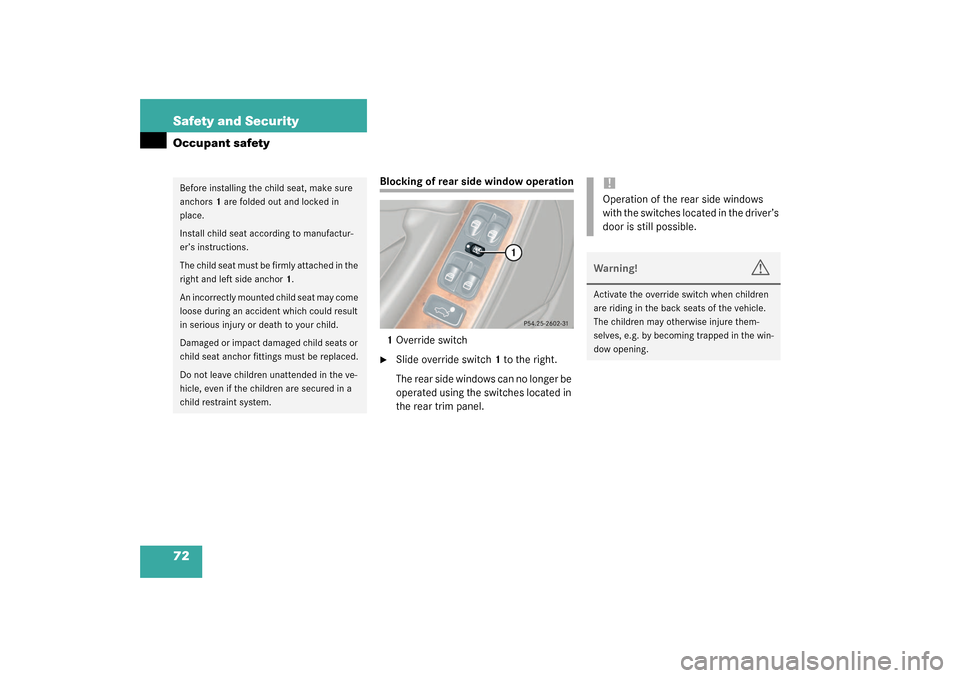
72 Safety and SecurityOccupant safety
Blocking of rear side window operation
1Override switch�
Slide override switch 1 to the right.
The rear side windows can no longer be
operated using the switches located in
the rear trim panel.
Before installing the child seat, make sure
anchors1 are folded out and locked in
place.
Install child seat according to manufactur-
er’s instructions.
T h e c h i l d s e a t m u s t b e f i r m l y a t t a c h e d i n t h e
right and left side anchor1.
An incorrectly mounted child seat may come
loose during an accident which could result
in serious injury or death to your child.
Damaged or impact damaged child seats or
child seat anchor fittings must be replaced.
Do not leave children unattended in the ve-
hicle, even if the children are secured in a
child restraint system.
!Operation of the rear side windows
with the switches located in the driver’s
door is still possible.Warning!
G
Activate the override switch when children
are riding in the back seats of the vehicle.
The children may otherwise injure them-
selves, e.g. by becoming trapped in the win-
dow opening.
Page 74 of 394
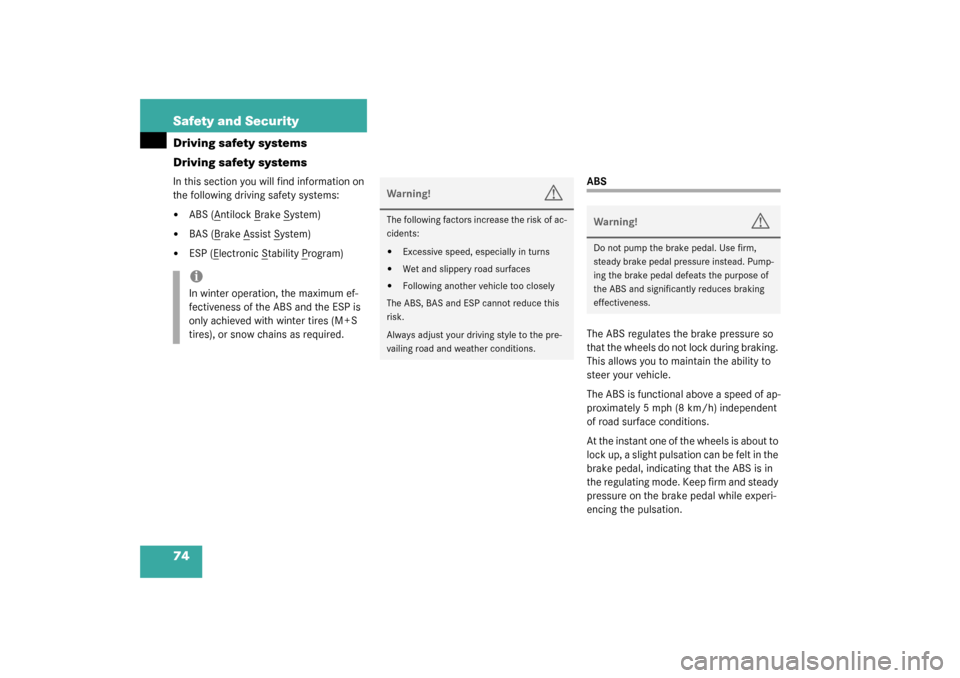
74 Safety and SecurityDriving safety systems
Driving safety systemsIn this section you will find information on
the following driving safety systems:�
ABS (A
ntilock B
rake S
ystem)
�
BAS (B
rake A
ssist S
ystem)
�
ESP (E
lectronic S
tability P
rogram)
ABS
The ABS regulates the brake pressure so
that the wheels do not lock during braking.
This allows you to maintain the ability to
steer your vehicle.
The ABS is functional above a speed of ap-
proximately 5 mph (8 km/h) independent
of road surface conditions.
At the instant one of the wheels is about to
lock up, a slight pulsation can be felt in the
brake pedal, indicating that the ABS is in
the regulating mode. Keep firm and steady
pressure on the brake pedal while experi-
encing the pulsation.
iIn winter operation, the maximum ef-
fectiveness of the ABS and the ESP is
only achieved with winter tires (M + S
tires), or snow chains as required.
Warning!
G
The following factors increase the risk of ac-
cidents:�
Excessive speed, especially in turns
�
Wet and slippery road surfaces
�
Following another vehicle too closely
The ABS, BAS and ESP cannot reduce this
risk.
Always adjust your driving style to the pre-
vailing road and weather conditions.
Warning!
G
Do not pump the brake pedal. Use firm,
steady brake pedal pressure instead. Pump-
ing the brake pedal defeats the purpose of
the ABS and significantly reduces braking
effectiveness.
Page 76 of 394
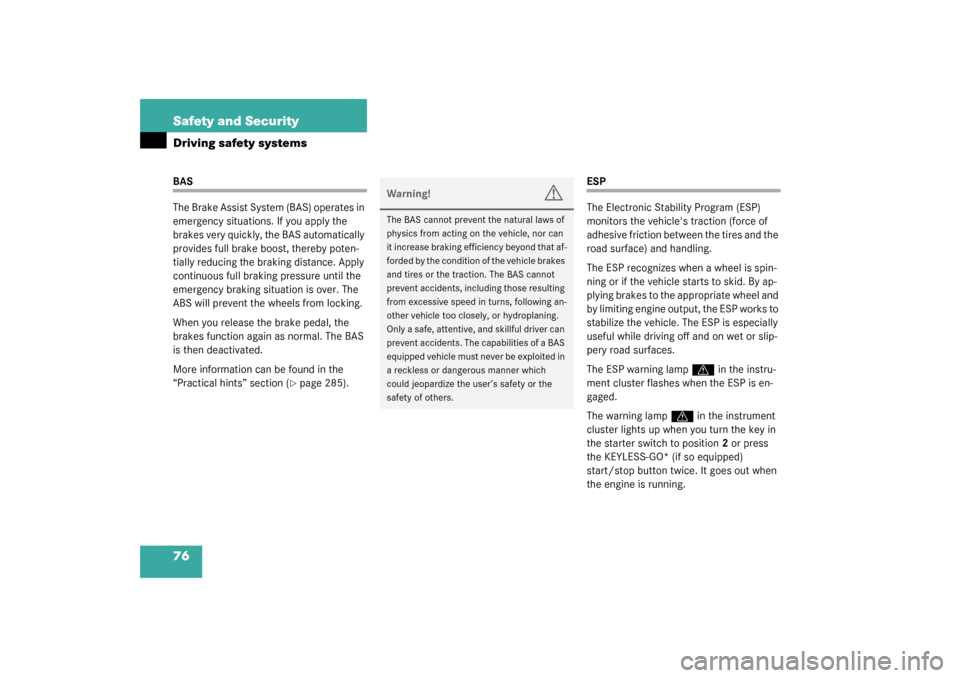
76 Safety and SecurityDriving safety systemsBAS
The Brake Assist System (BAS) operates in
emergency situations. If you apply the
brakes very quickly, the BAS automatically
provides full brake boost, thereby poten-
tially reducing the braking distance. Apply
continuous full braking pressure until the
emergency braking situation is over. The
ABS will prevent the wheels from locking.
When you release the brake pedal, the
brakes function again as normal. The BAS
is then deactivated.
More information can be found in the
“Practical hints” section (
�page 285).
ESP
The Electronic Stability Program (ESP)
monitors the vehicle's traction (force of
adhesive friction between the tires and the
road surface) and handling.
The ESP recognizes when a wheel is spin-
ning or if the vehicle starts to skid. By ap-
plying brakes to the appropriate wheel and
by limiting engine output, the ESP works to
stabilize the vehicle. The ESP is especially
useful while driving off and on wet or slip-
pery road surfaces.
The ESP warning lamp
v
in the instru-
ment cluster flashes when the ESP is en-
gaged.
The warning lamp
v
in the instrument
cluster lights up when you turn the key in
the starter switch to position2 or press
the KEYLESS-GO* (if so equipped)
start/stop button twice. It goes out when
the engine is running.
Warning!
G
The BAS cannot prevent the natural laws of
physics from acting on the vehicle, nor can
it increase braking efficiency beyond that af-
forded by the condition of the vehicle brakes
and tires or the traction. The BAS cannot
prevent accidents, including those resulting
from excessive speed in turns, following an-
other vehicle too closely, or hydroplaning.
Only a safe, attentive, and skillful driver can
prevent accidents. The capabilities of a BAS
equipped vehicle must never be exploited in
a reckless or dangerous manner which
could jeopardize the user’s safety or the
safety of others.
Page 80 of 394
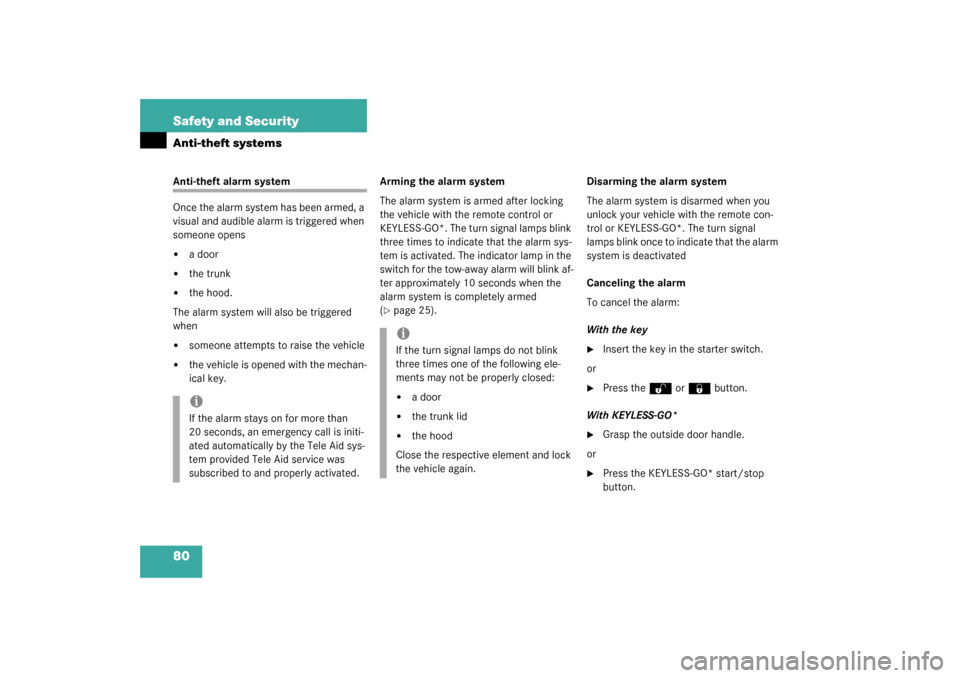
80 Safety and SecurityAnti-theft systemsAnti-theft alarm system
Once the alarm system has been armed, a
visual and audible alarm is triggered when
someone opens�
a door
�
the trunk
�
the hood.
The alarm system will also be triggered
when
�
someone attempts to raise the vehicle
�
the vehicle is opened with the mechan-
ical key.Arming the alarm system
The alarm system is armed after locking
the vehicle with the remote control or
KEYLESS-GO*. The turn signal lamps blink
three times to indicate that the alarm sys-
tem is activated. The indicator lamp in the
switch for the tow-away alarm will blink af-
ter approximately 10 seconds when the
alarm system is completely armed
(
�page 25).Disarming the alarm system
The alarm system is disarmed when you
unlock your vehicle with the remote con-
trol or KEYLESS-GO*. The turn signal
lamps blink once to indicate that the alarm
system is deactivated
Canceling the alarm
To cancel the alarm:
With the key
�
Insert the key in the starter switch.
or
�
Press the
Œ
or
‹
button.
With KEYLESS-GO*
�
Grasp the outside door handle.
or
�
Press the KEYLESS-GO* start/stop
button.
iIf the alarm stays on for more than
20 seconds, an emergency call is initi-
ated automatically by the Tele Aid sys-
tem provided Tele Aid service was
subscribed to and properly activated.
iIf the turn signal lamps do not blink
three times one of the following ele-
ments may not be properly closed:�
a door
�
the trunk lid
�
the hood
Close the respective element and lock
the vehicle again.
Page 81 of 394

81 Safety and Security
Anti-theft systems
Tow-away alarm
Once the tow-away alarm is armed, a visual
and audible alarm will be triggered when
someone attempts to raise the vehicle.
Arming tow-away alarm
When you lock your vehicle, the tow-away
alarm is automatically armed after about
30 seconds.
When you unlock your vehicle, the
tow-away protection disarms automatical-
ly.Disarming tow-away alarm
To prevent triggering the tow-away alarm
feature, switch off the tow-away alarm be-
fore towing the vehicle, or when parking on
a surface subject to movement, such as a
ferry or auto train.
1Tow-away alarm off switch
2Indicator lamp
The switch is located on the center con-
sole.
�
Turn off the ignition and remove the
key.
�
Press upper half1 of the switch.
Indicator lamp2 in the switch lights up
briefly.
�
Lock your vehicle with the key or (vehi-
cles with KEYLESS-GO*) the lock but-
ton at each door handle.
The tow-away alarm remains disarmed un-
til you lock your vehicle again.
iThe tow-away protection alarm is trig-
gered, for example, if the vehicle is lift-
ed on one side.
If the alarm stays on for more than
20 seconds, an emergency call is initi-
ated automatically by the Tele Aid sys-
tem provided Tele Aid service was
subscribed to and properly activated.
iYou cannot disarm the tow-away alarm
if the ignition is turned on.
Page 83 of 394
83 Controls in detail
Locking and unlocking
Seats
Memory function
Lighting
Instrument cluster
Control system
Automatic transmission
Good visibility
Automatic climate control
Audio system
Power windows
Sliding/pop-up roof*
Driving systems
Loading
Useful features
Page 84 of 394
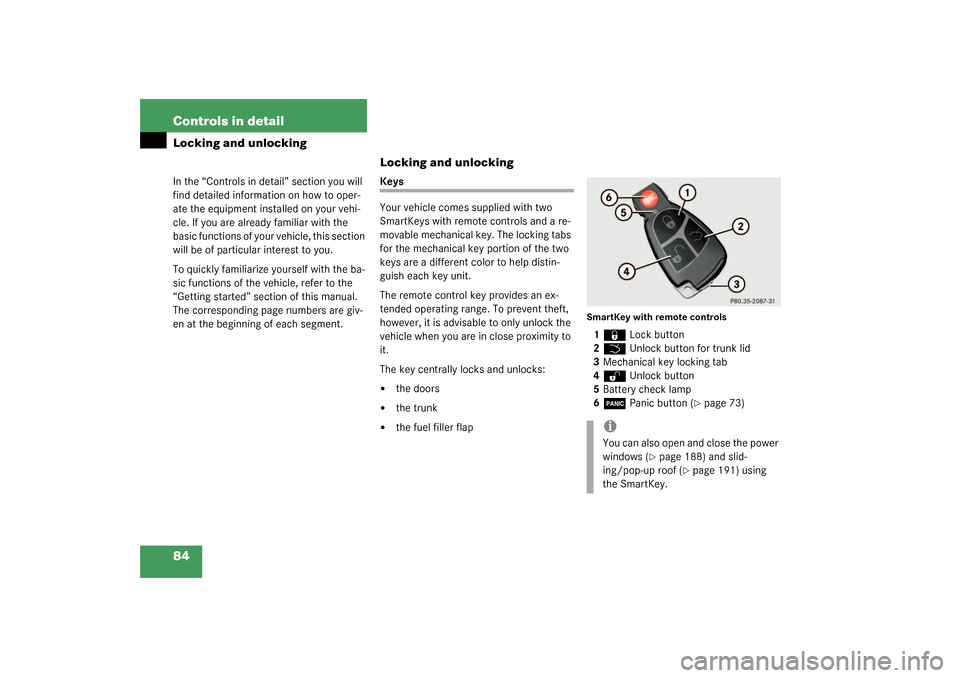
84 Controls in detailLocking and unlockingIn the “Controls in detail” section you will
find detailed information on how to oper-
ate the equipment installed on your vehi-
cle. If you are already familiar with the
basic functions of your vehicle, this section
will be of particular interest to you.
To quickly familiarize yourself with the ba-
sic functions of the vehicle, refer to the
“Getting started” section of this manual.
The corresponding page numbers are giv-
en at the beginning of each segment.
Locking and unlockingKeys
Your vehicle comes supplied with two
SmartKeys with remote controls and a re-
movable mechanical key. The locking tabs
for the mechanical key portion of the two
keys are a different color to help distin-
guish each key unit.
The remote control key provides an ex-
tended operating range. To prevent theft,
however, it is advisable to only unlock the
vehicle when you are in close proximity to
it.
The key centrally locks and unlocks:�
the doors
�
the trunk
�
the fuel filler flap
SmartKey with remote controls1‹
Lock button
2
Š
Unlock button for trunk lid
3Mechanical key locking tab
4
Œ
Unlock button
5Battery check lamp
6
Â
Panic button (
�page 73)
iYou can also open and close the power
windows (
�page 188) and slid-
ing/pop-up roof (
�page 191) using
the SmartKey.